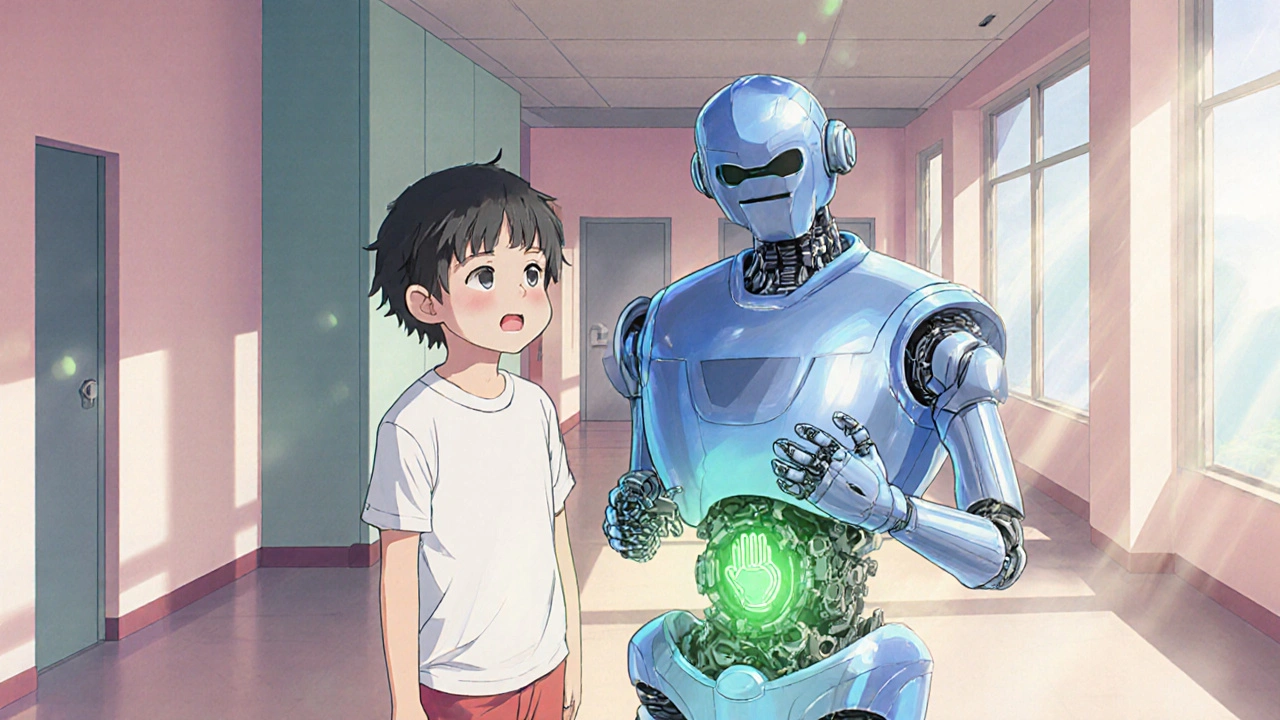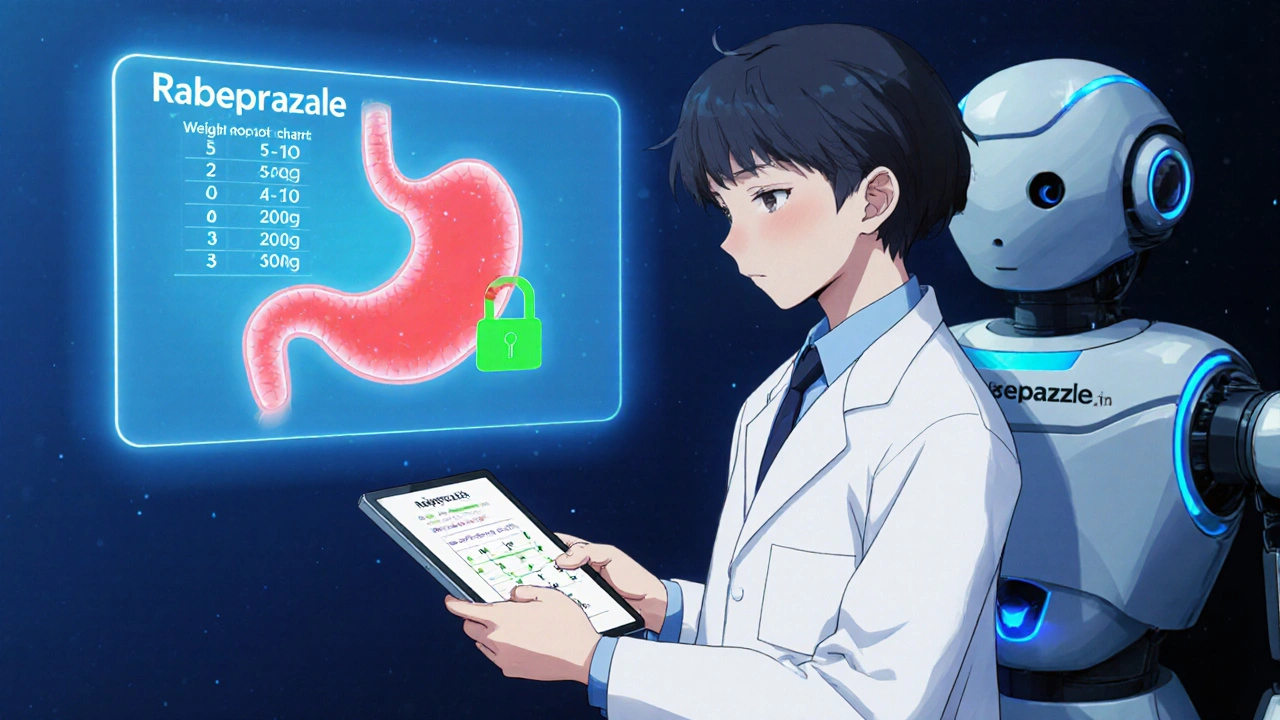 Oct, 18 2025
Oct, 18 2025
Rabeprazole Pediatric Dosage Calculator
Calculate Your Child's Rabeprazole Dose
This calculator determines the appropriate rabeprazole sodium dosage for children aged 12 years and older based on weight.
Recommended Dosage
Quick Takeaways
- Rabeprazole sodium is a proton pump inhibitor (PPI) approved for children 12 years and older.
- Typical pediatric dose is 5‑10 mg once daily, adjusted for weight and age.
- Clinical trials show it effectively reduces symptoms of GERD and peptic ulcer disease in kids.
- Common side effects are mild - headache, abdominal pain, and diarrhea.
- Serious risks (e.g., vitamin B12 deficiency, bone fractures) are rare but require monitoring.
What Is Rabeprazole Sodium?
When you see Rabeprazole Sodium is a proton pump inhibitor that blocks the final step of stomach acid production, think of it as a powerful off‑switch for the cells that pour out acid. It was first approved for adult use in 2001 and later gained pediatric clearance in the United States.
How Does It Work?
Rabeprazole belongs to the Proton Pump Inhibitor class, which targets the H+/K+ ATPase enzyme in gastric parietal cells. By binding covalently, the drug keeps the pump inactive for up to 24 hours, dramatically lowering the amount of acid that reaches the esophagus or duodenum.

Safety Profile for Children
Parents often wonder if rabeprazole sodium children is safe, and the short answer is yes for the approved age groups, but with caveats. The FDA has limited the label to kids 12 years and older because long‑term data below that age are sparse.
Key safety points:
- Short‑term use (up to 8 weeks) is well‑tolerated in clinical trials.
- Long‑term use may impair calcium absorption, increasing fracture risk - especially in adolescents with low dietary calcium.
- Because rabeprazole is metabolized primarily by the liver enzyme CYP2C19, children who are poor metabolizers may experience higher drug levels.
- Rare but serious events include Clostridioides difficile infection and acute interstitial nephritis.
Recommended Pediatric Dosage
Dosage is weight‑based and follows the same principle as other PPIs. The typical regimen looks like this:
- Children 12 years or older, weighing 30 kg (66 lb) or more: 20 mg (5 mg × 4) once daily.
- Those between 20‑30 kg: 10 mg once daily, preferably in the morning before breakfast.
- Never split the tablet; use the oral suspension if a lower dose is needed.
Always give the medication at least 30 minutes before a meal to ensure optimal absorption.
Comparing Rabeprazole With Other Pediatric Acid Reducers
When a doctor decides on an acid‑reducing strategy, they often weigh rabeprazole against alternatives like omeprazole, H2 blockers, or pro‑kinetics. Below is a quick snapshot.
| Attribute | Rabeprazole | Omeprazole | H2 Blocker (e.g., ranitidine) | Metoclopramide |
|---|---|---|---|---|
| Class | Proton Pump Inhibitor | Omeprazole (PPI) | H2 Blocker | Metoclopramide (pro‑kinetic) |
| Onset of Action | 1‑2 hours (max effect 4‑5 days) | 1‑3 hours (max effect 4‑5 days) | 30‑60 minutes (short‑term only) | 15‑30 minutes (motility, not acid) |
| FDA Pediatric Approval | 12 years+ | 12 years+ | All ages (off‑label common) | Not approved for GERD |
| Common Side Effects | Headache, abdominal pain, diarrhea | Nausea, abdominal pain, dizziness | Headache, constipation, dizziness | Fatigue, drowsiness, extrapyramidal symptoms |
| Long‑Term Concerns | Bone density, B12 deficiency | Same as rabeprazole | Tachyphylaxis, limited duration | Movement disorders |
Overall, rabeprazole gives stronger, more consistent acid suppression than H2 blockers and a similar safety profile to omeprazole, making it a solid first‑line option for chronic pediatric GERD.
Monitoring and Managing Side Effects
Even though most kids tolerate the drug well, doctors usually schedule a follow‑up after 4‑6 weeks to check:
- Symptom relief - less heartburn, fewer night‑time awakenings.
- Growth parameters - ensure the child’s weight and height stay on track.
- Lab work if therapy exceeds 6 months: calcium, vitamin B12, and magnesium levels.
If a child develops persistent diarrhea, severe headache, or signs of infection, contact the pediatrician immediately. In rare cases of allergic reaction (rash, swelling, difficulty breathing), stop the medication and seek emergency care.
Frequently Asked Questions
Can rabeprazole be used in children under 12 years?
Current FDA labeling restricts use to kids 12 years and older. Some specialists may prescribe it off‑label for younger children, but that decision requires careful risk‑benefit analysis and close monitoring.
How long should a child stay on rabeprazole?
For uncomplicated GERD, 4‑8 weeks is typical. Chronic conditions may need longer therapy, but doctors should reassess every 6‑12 months to decide if continued use is warranted.
Is it safe to combine rabeprazole with antacids?
Yes, short‑term use of antacids for breakthrough symptoms is fine, but avoid taking them within 30 minutes of the rabeprazole dose because they can raise stomach pH and reduce the drug’s effectiveness.
What should I do if my child misses a dose?
Give the missed dose as soon as you remember, unless it’s almost time for the next dose. In that case, skip the missed one and continue with the regular schedule - never double‑dose.
Are there natural alternatives to rabeprazole for kids?
Lifestyle changes-elevating the head of the bed, smaller meals, avoiding chocolate and citrus-can help mild GERD. However, they rarely replace medication when esophagitis or ulcer disease is present.
Bottom line: rabeprazole sodium is a powerful, well‑studied option for kids who truly need acid suppression. With the right dosage, regular check‑ins, and attention to side effects, most children experience relief without major problems.
Sarah Unrath
October 18, 2025 AT 23:46the dosage chart looks fine but i wish they mentioned how to split the suspension for kids under 20kg
James Dean
October 21, 2025 AT 16:54considering the pharmacokinetics of rabeprazole the fact that CYP2C19 variability exists in adolescents is a reminder that personalization matters more than blanket dosing
Rakhi Kasana
October 24, 2025 AT 10:03Honestly the guide oversimplifies the risk of bone density loss; parents should demand a baseline DEXA before committing to long‑term therapy
dennis turcios
October 27, 2025 AT 03:11while the precaution is valid the data actually shows only a marginal decrease in calcium levels and most pediatric studies report no significant fracture increase
Caroline Keller
October 29, 2025 AT 20:20it breaks my heart seeing kids suffer from silent reflux and then being told to just take a pill without addressing diet or stress that often fuel the problem
Felix Chan
November 1, 2025 AT 13:28you’re right, but the good news is that when the medication is combined with simple lifestyle tweaks many families notice rapid symptom relief and happier evenings
Leo Chan
November 4, 2025 AT 06:37let’s remember that every child is unique; starting with the lowest effective dose and monitoring growth charts can keep the treatment on the safe side
jagdish soni
November 6, 2025 AT 23:46indeed the nuanced interplay between gastric acid suppression and endocrine homeostasis warrants a holistic appraisal beyond mere symptom scores
parth gajjar
November 9, 2025 AT 16:54what many overlook is the subtle cascade where prolonged suppression subtly rewires mucosal immunity leading to unexpected infections like C. difficile in otherwise healthy youngsters
Maridel Frey
November 12, 2025 AT 10:03From a clinical perspective, it is advisable to schedule a follow‑up endoscopy after six months of continuous therapy to assess mucosal healing and adjust dosage accordingly
Monika Bozkurt
November 15, 2025 AT 03:11Indeed the longitudinal surveillance protocol should incorporate serum calcium, 25‑hydroxyvitamin D, and serum gastrin measurements to preemptively identify metabolic derangements associated with chronic proton pump inhibition
ashanti barrett
November 17, 2025 AT 20:20I appreciate the comprehensive dosage table yet I would stress the importance of timing the dose relative to breakfast to maximize bioavailability and reduce nocturnal reflux episodes
Thokchom Imosana
November 20, 2025 AT 13:28while the timing recommendation aligns with standard pharmacology it is noteworthy that the pharmaceutical industry has subtly influenced prescribing guidelines to favor extended‑release formulations thereby ensuring a steady market demand and minimizing the need for costly patient education initiatives
Jameson The Owl
November 23, 2025 AT 06:37the official approval of rabeprazole for adolescents was a calculated move by regulatory bodies under pressure from big pharma. the clinical trials that supported the label were funded by the same manufacturers that stand to profit from millions in prescriptions. these studies conveniently excluded children under twelve citing lack of data while simultaneously lobbying for off‑label use. the omission of long‑term bone health data is not an oversight but a strategic omission to avoid alarm. pediatric gastroenterologists are often swayed by sponsored conferences that present biased efficacy data. the drug’s metabolism through CYP2C19 varies widely among ethnic groups yet dose recommendations remain one‑size‑fits‑all. such variability increases the risk of supratherapeutic levels in poor metabolizers a fact downplayed in marketing literature. the reported side effects like headache and diarrhea are trivial compared to the silent erosion of calcium stores. overuse of acid suppressors has been linked to increased susceptibility to enteric infections a correlation that is rarely highlighted. the push for early and aggressive treatment stems from a paradigm that equates symptom control with disease cure. however the gut microbiome thrives on a balanced pH and chronic suppression can destabilize this delicate ecosystem. the rise in pediatric Clostridioides difficile cases aligns temporally with the surge in proton pump inhibitor prescriptions. parents are often unaware that over‑the‑counter antacids can interfere with rabeprazole absorption further complicating therapy. transparent independent research is essential to unravel these hidden risks and guide evidence‑based practice. until such data become publicly available clinicians should adopt a cautious individualized approach and prioritize non‑pharmacologic strategies.
DHARMENDER BHATHAVAR
November 25, 2025 AT 23:46consistent monitoring keeps therapy safe